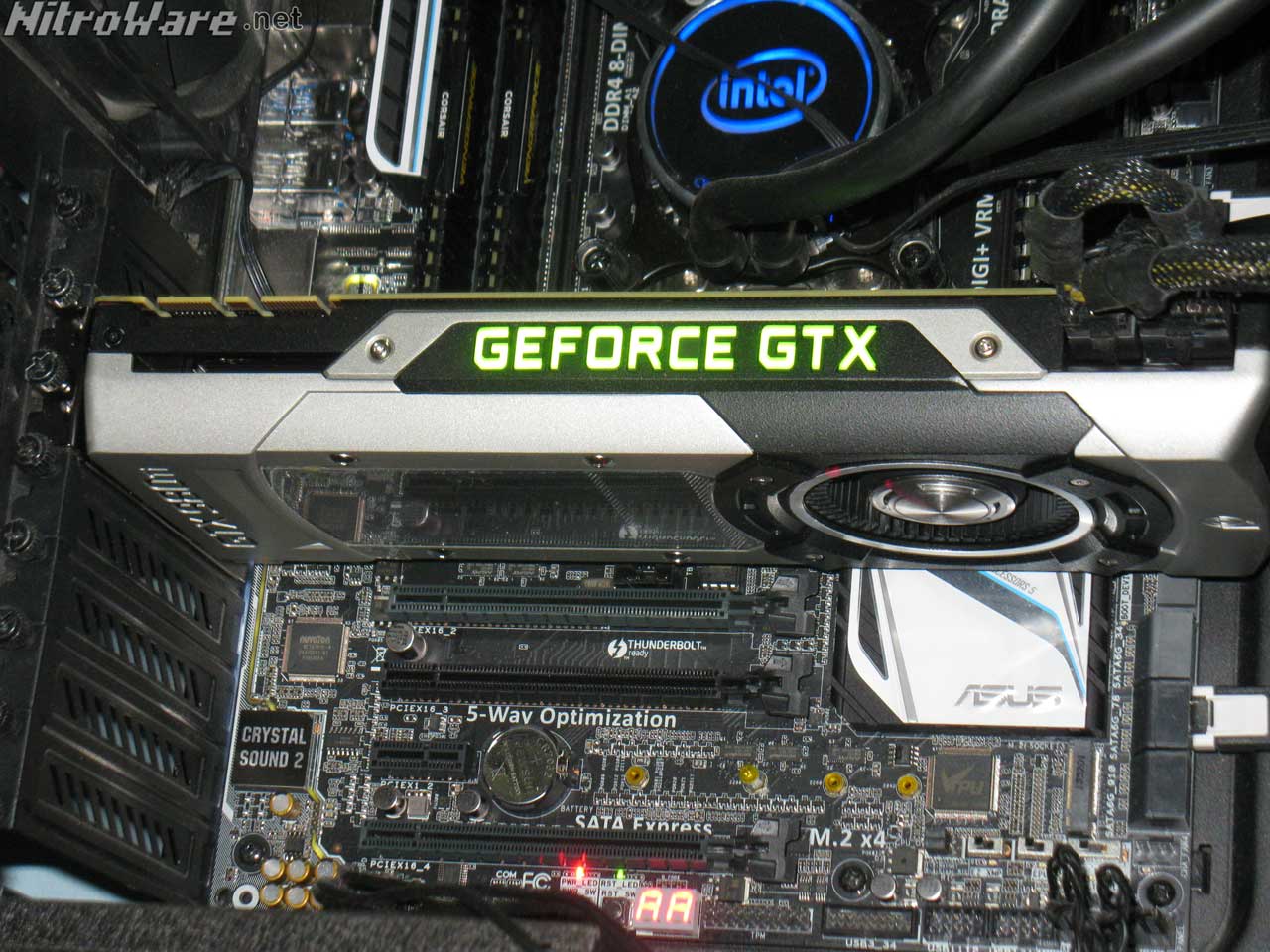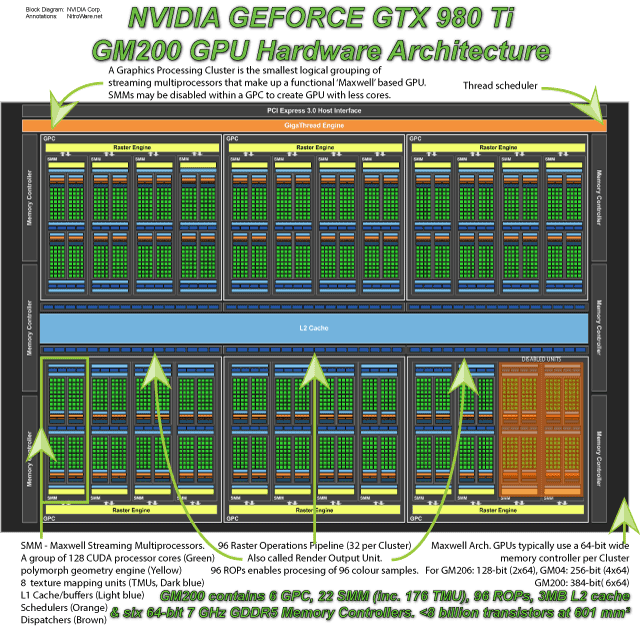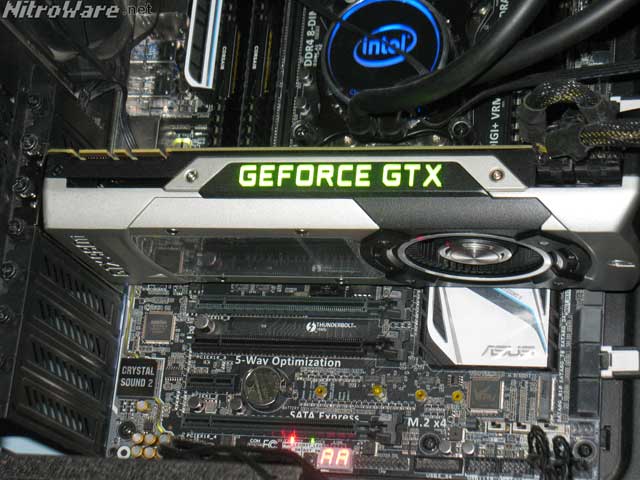
A mere quarter after launching the impressive TITAN X, NVIDIA is launching another powerful flagship graphics card GPU from its silo leveraging the technology and design from the TITAN X GPU to deliver and maintain flagship performance. Enthusiasts wanted TITAN X performance at a lower price and we have got it. In our testing, 980 Ti reference card matched and even beat TITAN X in some benchmarks, yet significantly , faster add-in-board partner custom overclocked 980 Ti are coming. All of which posing a significant thread to AMD’s plans of Fast and ‘Furious’ domination of the high end graphics segment.
NVIDIA’s GTX 980 Ti is the fastest graphics card we have tested. Combined with support for DirectX 12 Feature Level 1 and updates to G-SYNC and Gameworks to optimize the VR experience, the standard has been set for AMD’s upcoming GPU release.
Due to an extremely tight review deadline, we present overall benchmarks in our launch review. Additional Benchmarks, Third Party Board specs and pricing and hardware tear-down/analysis may be added and updated to this review in the days after publishing.
Introducing GTX 980 Ti
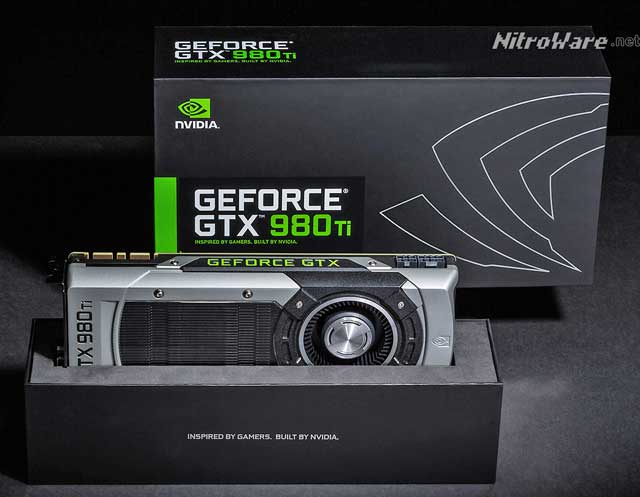 Enthusiasts out there anticipating the GTX 980 Ti are likely familiar enough with 2nd generation Maxwell GPUs and want to skip straight to the point, great so do we. But first, before we get to the benchmarks:
Enthusiasts out there anticipating the GTX 980 Ti are likely familiar enough with 2nd generation Maxwell GPUs and want to skip straight to the point, great so do we. But first, before we get to the benchmarks:
980 Ti takes the ‘full’ TITAN X implementation of NVIDIA’s GM200 GPU and disables 2 of the 24 SMX units giving us 2816 shader cores, 176 Texturing Units and 96 ROPS, essentially a cut down version of TITAN X without any significant performance penalties or caveats, other than reduced texturing throughput and computational performance.
Now about those disabled units… Noting the general arrangement of the logical and physical processing units on the GPU as we have described, NVIDIA have elected to disable only half of a processing cluster which is the smallest usable logical unit of the GPU. Disabling half of the cluster preserves the Rasterization units and memory controllers.
In the official and simplified marketing diagram for the GPU which we annotated above, one may notice the excess ROPS and Raster Engine once the two SMM units are disabled.
Does this mean that these ROPS and Rasterizes while present are idle and not used/connected to any GPU cores? Not Necessarily.
What the diagram is missing is various crossbar buses which connect all the logical and compute units of the GPU together such as the SMMs, GPCs, the Cache and memory controllers.
Yes a fully populated Graphics Cluster with its 4 SMMs can make best use of its adjacent ROPS and rasterizers, but a less populated cluster can still use all the units via a crossbar bus at the expensive of some efficiency.
Under utilized ROPS and Rasterization Engine may sound like the situation with 970M where the partitioned memory is slower and not fully utilized but the difference with 980 Ti and GM200 is no memory controllers are crippled. All the hardware is present, except that some cores and texturing units are disabled. According to our testing we did not experience any performance regression compared to a TITAN X, especially at 4K Ultra Max Details.
We will still observe and report on the caveats of using this method (disabling SMMs) to produce different GPUs.
At 5.6 Tera-flops, 980 Ti is NVIDIA’s fastest consumer oriented GPU and now oddly enough, both its computing performance and texturing throughput match those of some third party editions of AMD’s Radeon R9 290X. With paper specs the same, it makes comparing efficiency of both cards, ie which is actually faster in game much more interesting.W
Since 980Ti does use the GM200 GPU from TITAN X, it also carries along the same PCB, therefore the memory system and importantly power supply topology. This product refresh mirrors what we saw from NVIDIA in 2012-2013 almost exactly. Early 2012 saw the GK104 powered GTX680 ship, it has a simplified onboard power supply which allowed for flexible customization by third party add in board partners and cost optimization. GTX 680 and 980 used high/low side MOSFET and driver sets while TITAN, 780/Ti, TITAN X and 980 Ti use fully integrated digital power chips which we described in our TITAN X review. AIB partners are not permitted to increase the video memory from 6GB.
Early 2013 brought us the first generation GTX TITAN built on GK110 with a premium heatsink-fan assembly and on-board power supply. Mid 2013 brought us the GTX 780 also with GK110 and the now iconic silver NVIDIA cooler and late 2013 brought the 780Ti.
The same cycle repeats itself for 2014-2015. late 2014 saw the launch of the cost optimized GTX 980 (albiet with the premium cooler unlike GTX 680) with GM204 core, followed up again by a refreshed TITAN X again fitted with a larger GM200 core. We now finally have the 980 Ti which ups the ante and provides a true flagship to the GPU stack. There actually is not much more headroom left for Maxwell GM200 series GPUs, which will have to battle AMD’s upcoming parts with high bandwidth memory and wait out the market until 2016’s ‘Pascal’ GeForce Refresh.
| Card | GTX 680 | GTX 780 Ti | GTX 980 | GTX TITAN X | GTX 980 Ti | R9 290X |
|---|---|---|---|---|---|---|
| Pixel Fillrate (GP/s) | 32.2 | 42 | 72 | 96.2 | 96 | 64 |
| Texture Fillrate (GT/s) | 128.8 | 210 | 144 | 192 | 176 | 176 |
| Memory Bandwidth (GB/s) | 192 | 336 | 224 | 337 | 337 | 320 |
| Single Precision Compute (GFLOPS) | 3090 | 5046 | 4612 | 6200 | 5632 | 5632 |
| Double Precision Compute (GFLOPS) | 195 | 210 | 144 | 192 | 176 | 704 |
| Single Precision Efficiency(GFLOPS/Watt) | 15.85 | 20.2 | 28 | 24.6 | 22.5 | 19.4 |
- CUDA/Shader core count between Kepler ‘SMX’ and Maxwell ‘SMM’ modules on the GPU should not be compared due to architectural differences.
- Dual GPU GTX TITAN Z board omitted for clarity, specs are slightly less than two TITAN Black
- Maxwell GM200 series retains 1/32 double precision performance of GeForce
- TFLOPS is calculated as 2x core count x clock speed. For Titan X NVIDIA took the Boost clock. 2x 3072 x 1089 = 6.63 TFLOPS which correlates to NVIDIA’s stated 7 TFLOPS as advertised, however we have used the base clock for our values, as for NVIDIA GPUs the base clock is guaranteed minimum.
GTX 960 and its GM206 GPU introduced an updated video processor which fully supported H265 HEVC video compression and decompression in hardware, however this updated unit didn’t make it into GM200 and neither TITAN X or 980 Ti have this enhanced NVENC video unit.
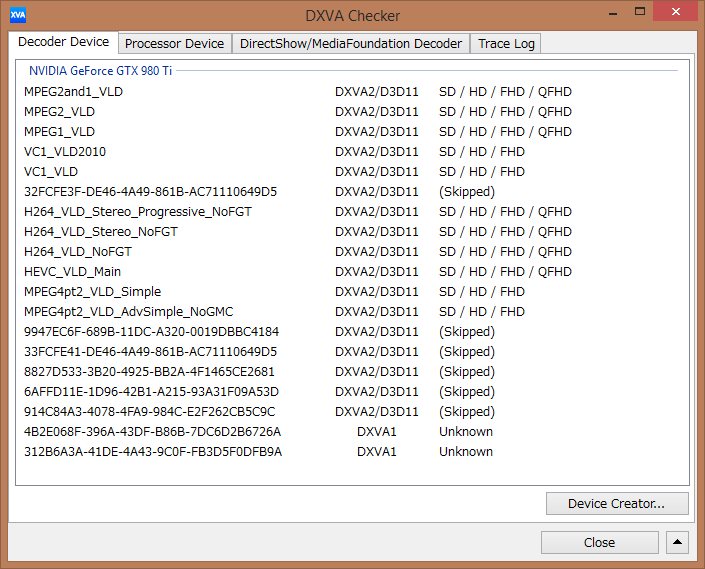
GTX 960 shipped with full DirectX12 branding on the box and simultaneously NVIDIA widely spoke of how GEFORCE was the preferred DirectX12 GPU for Microsoft as well as ISV demos. With WHQL drivers for Win 10 already published and basic DirectX12 evaluations already performed on Windows 10, with 60 days to go before the operating system’s release NVIDIA are now being very specific on which of their Geforce GPUs support which features and to drive the point home that they are fully DX12 compliant
During our briefing on GTX 980 Ti, Mobile G-SYNC and Gameworks VR we were informed that 2nd generation Maxwell supports the optional DirectX 12 Feature Level 1 while older GPUs such as Fermi would receive support through the Direct3D 12 API for common DirectX 12 software features as they lack the necessary hardware.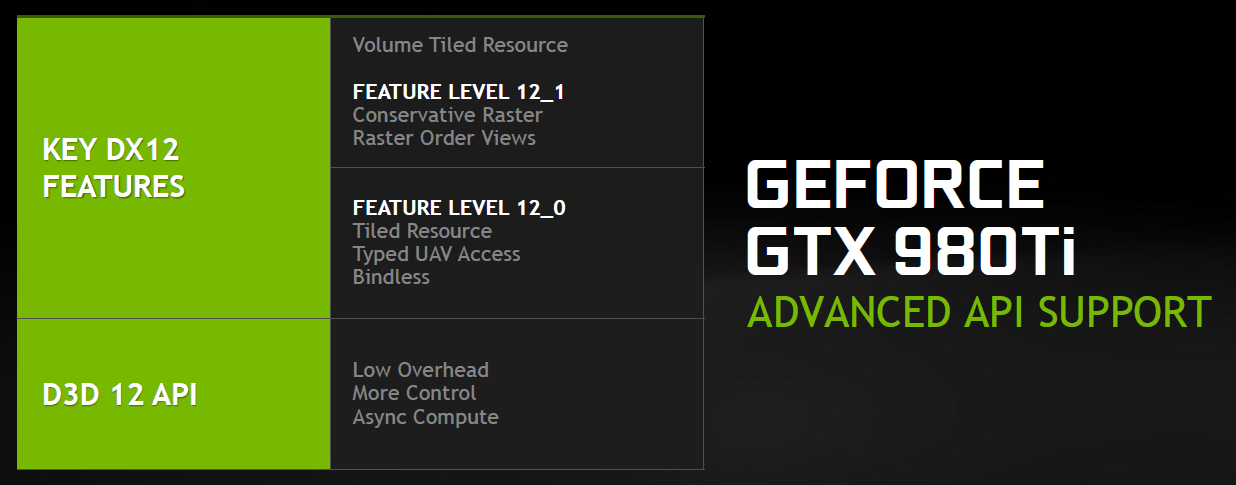
Test Specifications and Methodology
We test only with updated drivers, while this makes comparison difficult, when looking at new graphics cards a new driver is necessary and unavailable anyway. Additionally as an Australian publication we cannot retest hardware with new drivers as the majority of review hardware we receive from vendors must be returned
Stating the CPU configuration is also important, as motherboards using Intel’s Z or X chipset when paired with an unlocked Intel CPU will overclock that CPU ‘out of the box’ to maximize its potential. Other review sites will not state, or even know the true clockspeed and CPU core settings their test machines are set to.
| Type | Test Machine Specs |
|---|---|
| Graphics Cards | EVGA GEFORCE GTX 960 SSC edition NVIDIA GEFORCE GTX 980 reference card NVIDIA GEFORCE GTX TITAN X reference card ASUS ROG GEFORCE GTX 980 MATRIX Platinum edition NVIDIA GEFORCE GTX 980 Ti reference card AMD RADEON R9 290X press edition |
| Graphics Drivers | 980 Ti 352.90/353.06, TITAN X/ROG 980/EVGA 960 350.12/352.86 GTX 980 344.16, R9 290X Catalyst 14.4 |
| CPU | INTEL 4th Gen Core i7-5960X - 3.2GHz to 3.5GHz 8 Core 16 Thread Intel TS13X Liquid Cooler |
| Mainboard | GIGABYTE X99-Gaming G1 ASUS X99-A/USB 3.1 |
| Memory | Crucial 4 x 4GB Desktop Series DDR4-2133 modules Corsair 4 x 4GB Dominator LPX DDR4-2800 modules |
| BIOS settings | Default - Multi Core Enhancement and XMP off by default. RAM run at 21333 For GTA V testing, XMP mode selected in ASUS BIOS which enables DDR4-2800, 127 BCLK x 28 multiplier resulting in 3564 MHz CPU speed with all core ratios synced |
| Chassis | Corsair Vengeance C70 Gaming Tower - 2 Intake Fans 1 Exhaust |
| Power Supply | FSP Aurum C750 80 GOLD 750W |
| Display | DELL UP2414Q 4K 60Hz |
| OS | Windows 8.1 Pro 64bit |
tested at 15-20 C ambient. Power tests at Full HD resolution.
| Benchmarks | Desc |
|---|---|
| Crysis 3 | Welcome to the Jungle - Rendezvous with Psycho |
| Battlefield 4 | South China Sea - Valkyrie |
| World of Tanks | Basic Training |
| Wolfenstein: New Order | Prologue Mission, Bomber Run |
| Blender | BMW1M-MikePan.blend |
| Evil Within | Intro Mission - Until Captured |
Ambient Temperature:
GTX 980/ ROG 980/ GTX 960/ TITAN X tested at 25-29 C ambient room temperature, while 980 Ti was tested at 15-20 C ambient.
GTA V Benchmarked at 4K, 1440p and 1080p
With Grand Theft Auto V being the record breaking entertainment milestone that it is and a PC hardware Goliath in its requirements, we want to start with it. We note that testing the typical resolutions is NOT enough with GTA5. Whereas a modern PC game (with exclusions, eg Metro) can comfortably be run at Very High to Ultra plus Anti-Aliasing on a recent 2GB GPU, GTA5 takes things up a notch in the settings dept. Maximum details in this game require Ultimate level GPUs with at least 6GB of VRAM. As such we test at both ‘defaults’ which is almost a very high without anti aliasing and ‘max’ which is all sliders up, anti aliasing and enhanced draw distances enabled. Defaults look ok but the extreme PC enthusiast will want to run with everything enabled and up, which ‘defaults’ cant deliver’.
We use a weighed average to calculate GTAV’s performance as one segment of its benchmark test is longer thasn the others. Due to a change of test method, all GTA V benchmarks are with DDR4-2800 Memory and a 127MHz BUS, resulting in a 50MHz clock-speed increase for the Intel i7-7 5960X processor.
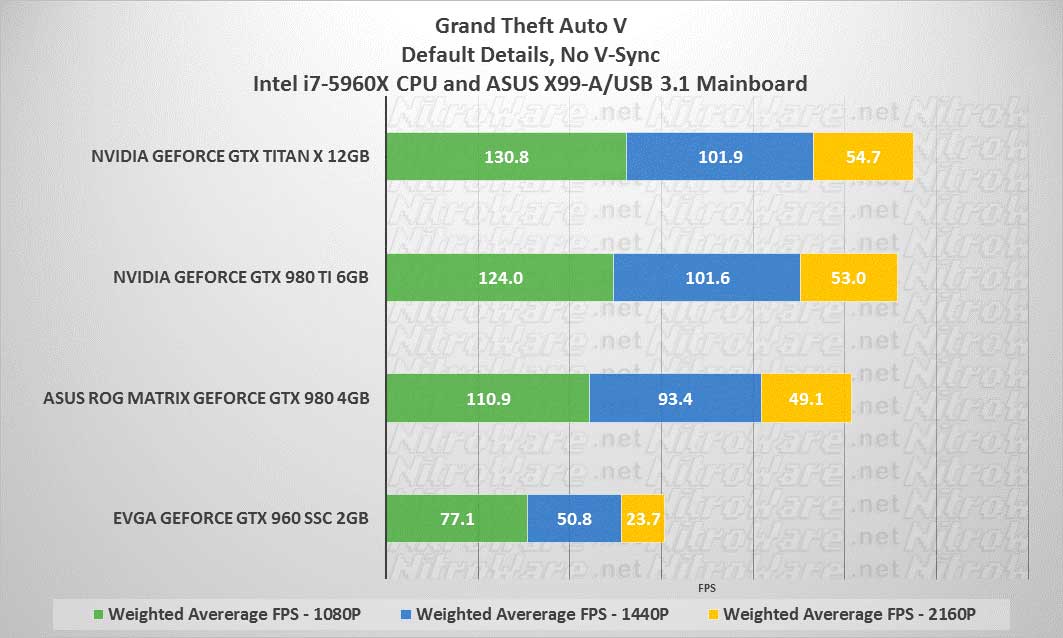
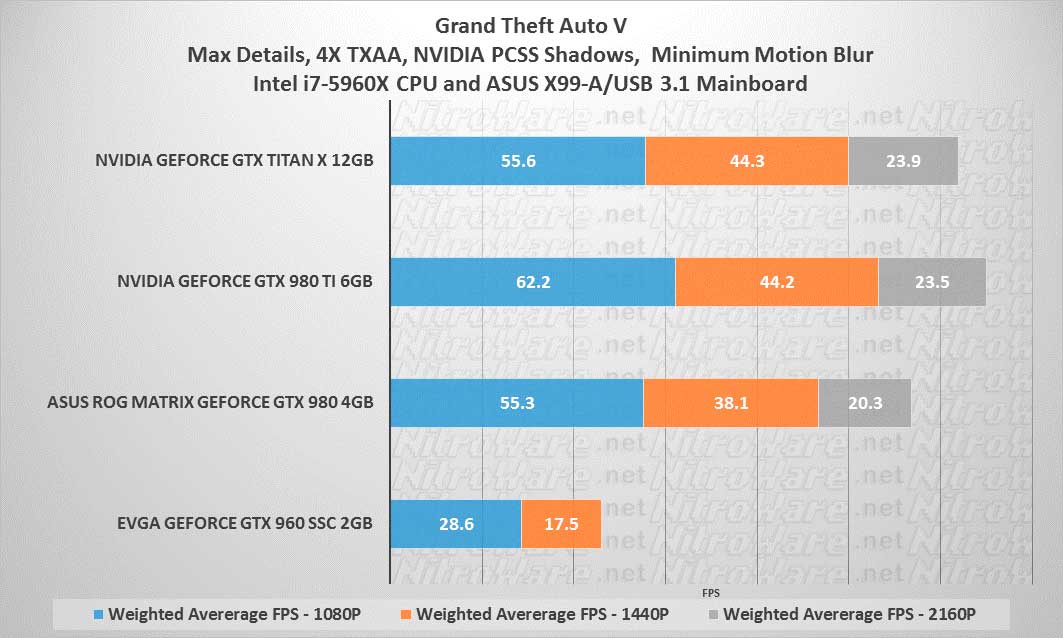
The 2GB GTX 960 failed the 4K Max test as it just rendered corrupt textures, too much video memory is needed by GTA specifically here.
In some of our 980 Ti benchmarks, the 980 Ti has a few frames advantage over the TITAN X as we have noticed the 980 Ti holds boost longer and we tested in colder temperatures.
Gaming Benchmarks - 4K
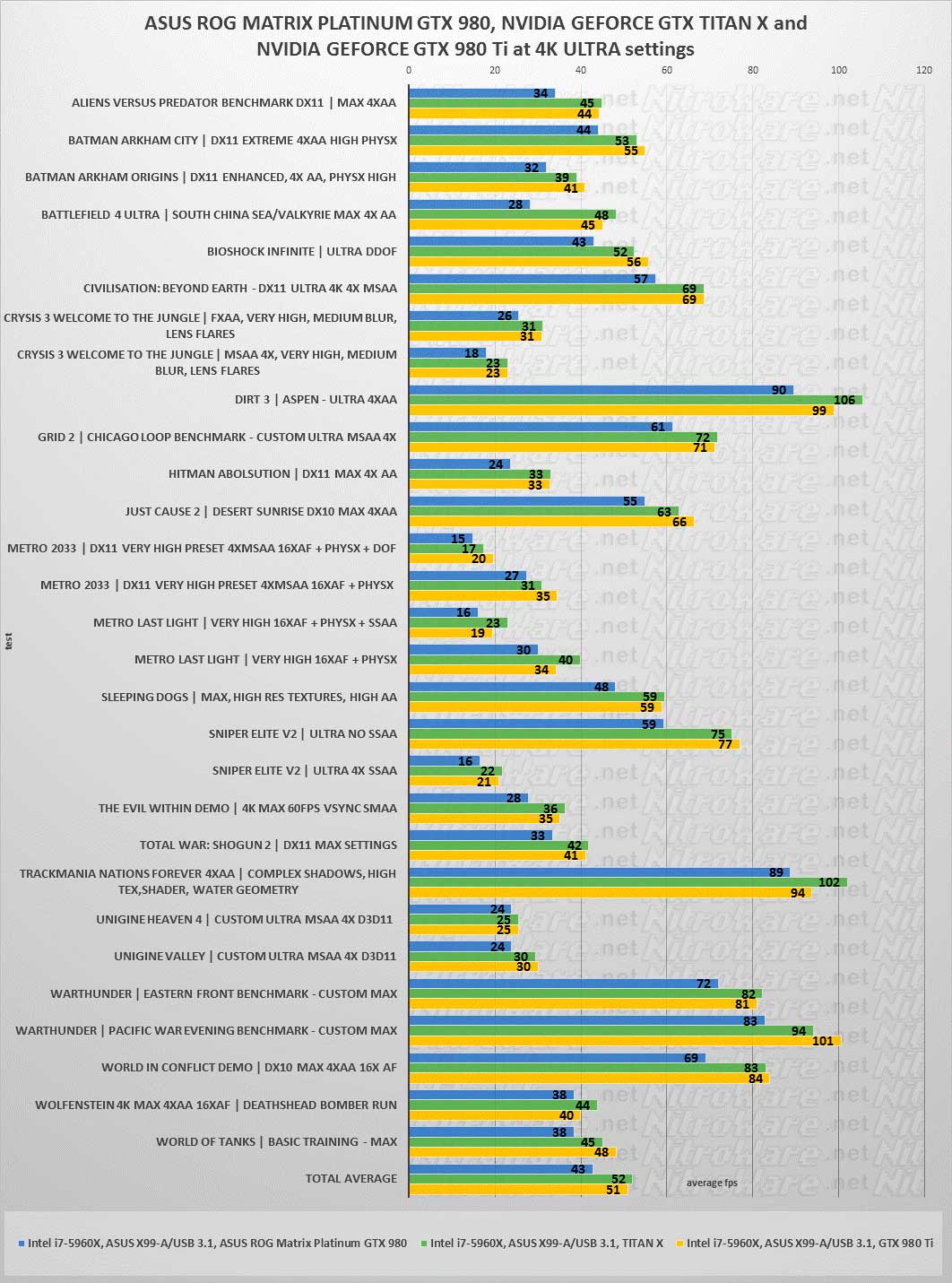
Sleeping Dogs performance at 4K with varying Anti-Aliasing
Sleeping dogs as a unique Anti-Aliasing setup so we can use that to test the effects of FXAA and Super-sampling Anti-aliasing
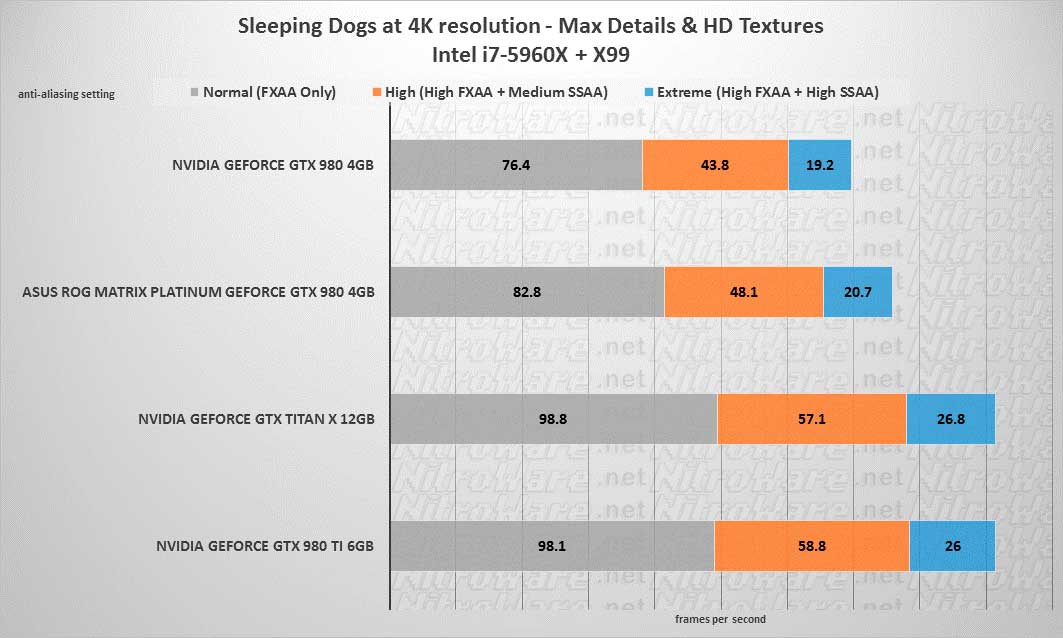
3DMark Firestrike and Overclocking.
3DMark Firestrike, Extreme and Ultra let us compare the 3D performance of different PCs in a standardized unified way. It not only tests 3D performance but includes some CPU physics tests to somewhat emulate a modern game.
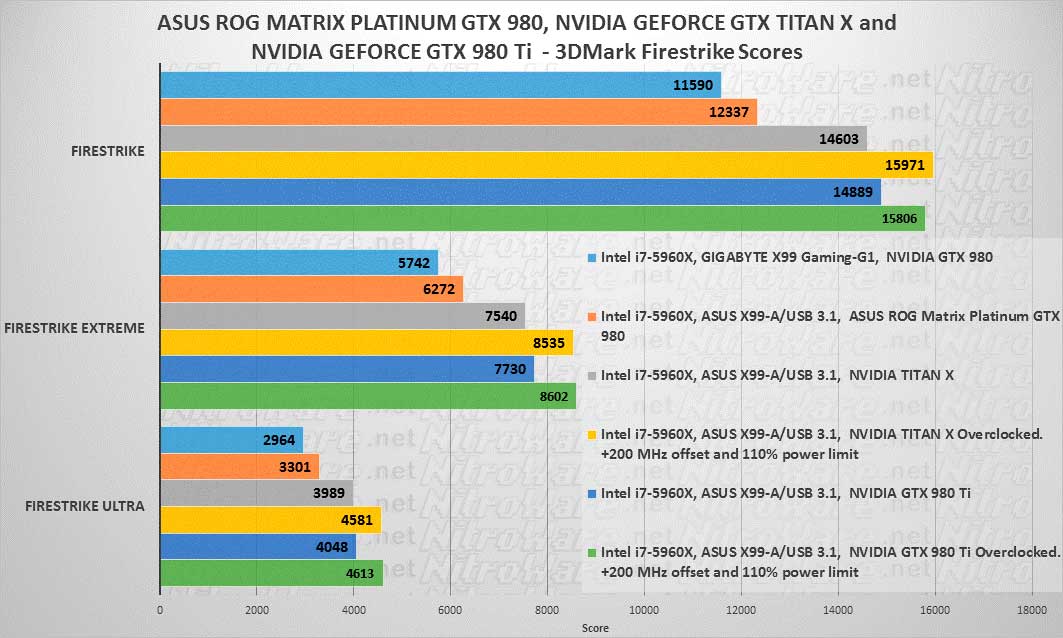
Our overclocking tests were simple. We used Firestrike as a performance and stability reference. With our GTX 980 Ti reference card sample set at 110% Power limit and 91c temperature limit using version 5.3.5 of EVGA Precision provided by NVIDIA for review, we found a +200MHz offset for the Core and Memory to be stable in Firestrike. Any higher combinations were not stable at stock voltages. This was the same as we experienced with our TITAN X review unit prior. In this 200 MHz offset overclock state, we observed boost speeds in game of up to 1402MHz Core, versus 1202 high boost typically at the stock clocks.
Note that TITAN X and GTX 980 Ti are clocked the same for Base and Boost, but that does not mean they should both boost identically as many factors affect this such as the disabled units in the 980 Ti, Video BIOS/driver tweaks, ambient temperature.
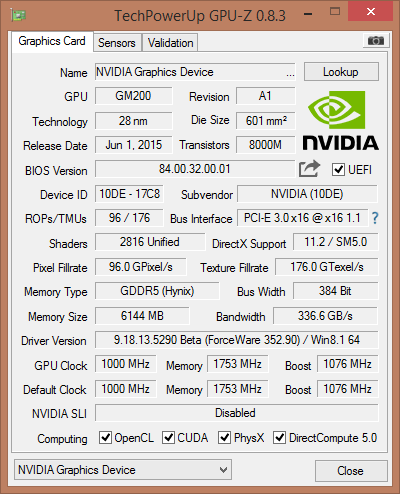
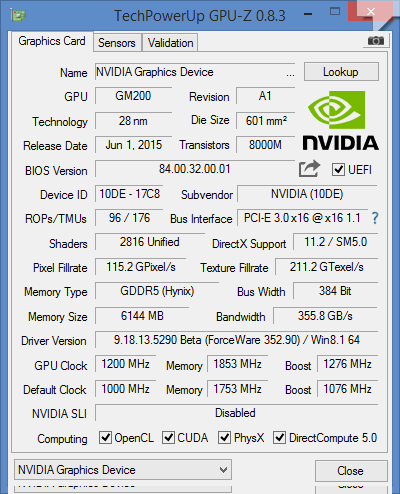
“NVIDIA Graphics Device” is a by product of the 352.90 BETA drivers provided to media to be able to test the 980 Ti before release date of June-1. NVIDIA subsequently released 353.06 WHQL drivers later on June-1 which address this and include some minor updates for the GeForce family.
Maximum Temperature of the 980 Ti is no different to the TITAN X in that both reach 83C before throttling down their boost speed. What we did notice though is 980 Ti stayed in boost longer and was more consistent where as TITAN X would over drop to its base clock so it could cool down.
Gaming Benchmarks - 1080p and 1440p
Furmark, 3D Mark, Unigine Heaven and Valley
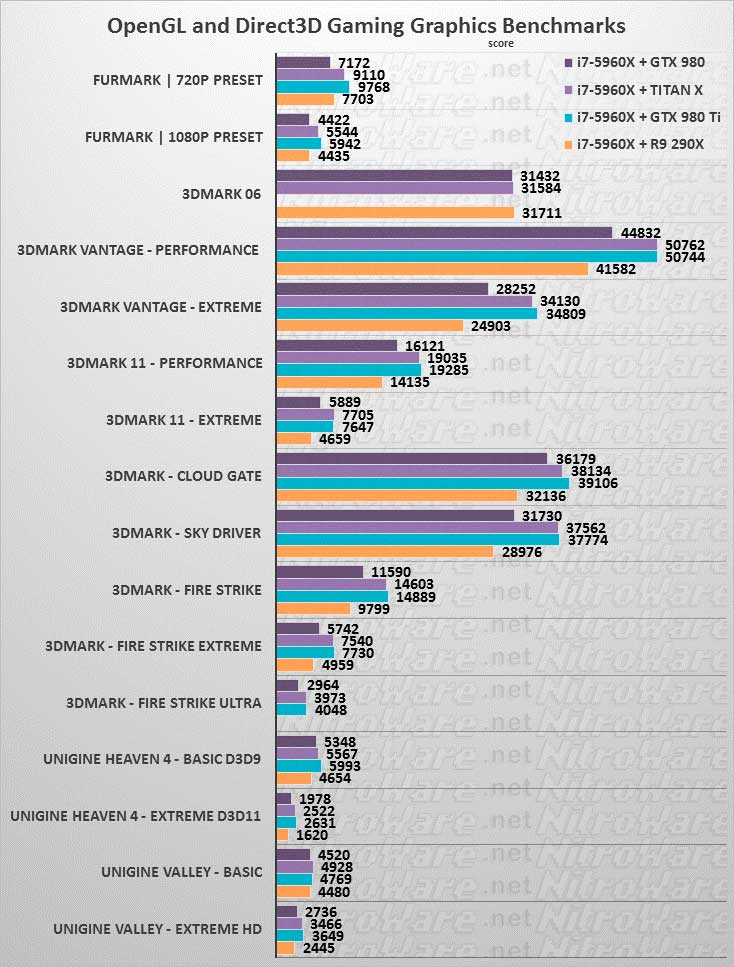
Trackmania Nations Forever, Sleeping Dogs, Just Cause 2, Star Swarm
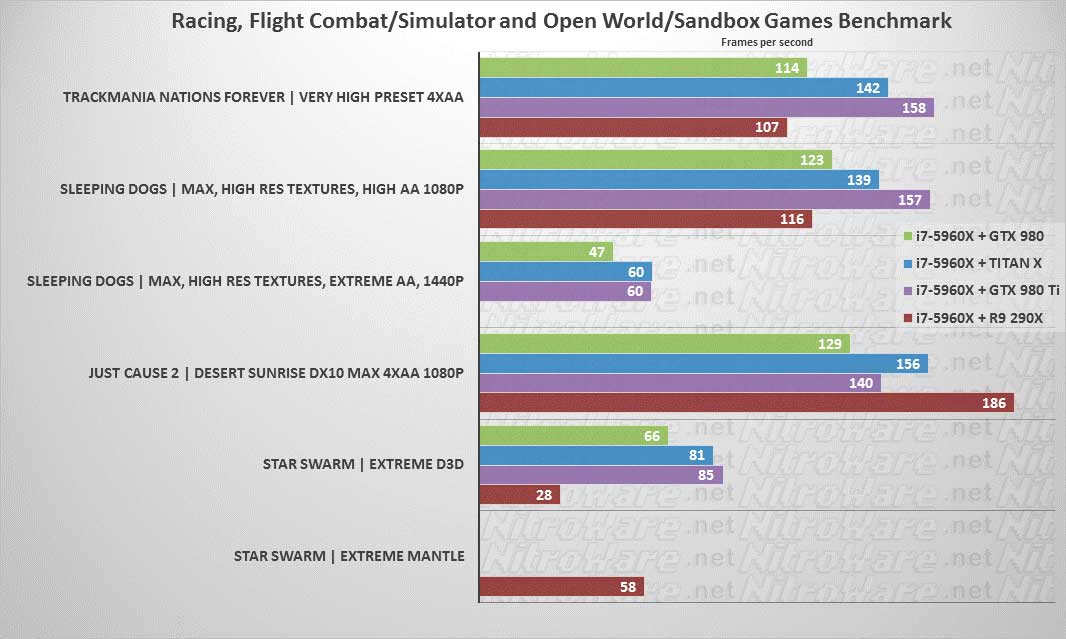
R9 290X results must be considered carefully and we only provide this for reference. The 290X sample we used was faulty and the results are now out of date due to driver updates. Note that Mantle Is and will be slower than NVIDIA’s D3D11 implementation in this specific test.
Batman: Arkham City, Hitman: Absolution, Resident Evil 5 Benchmark
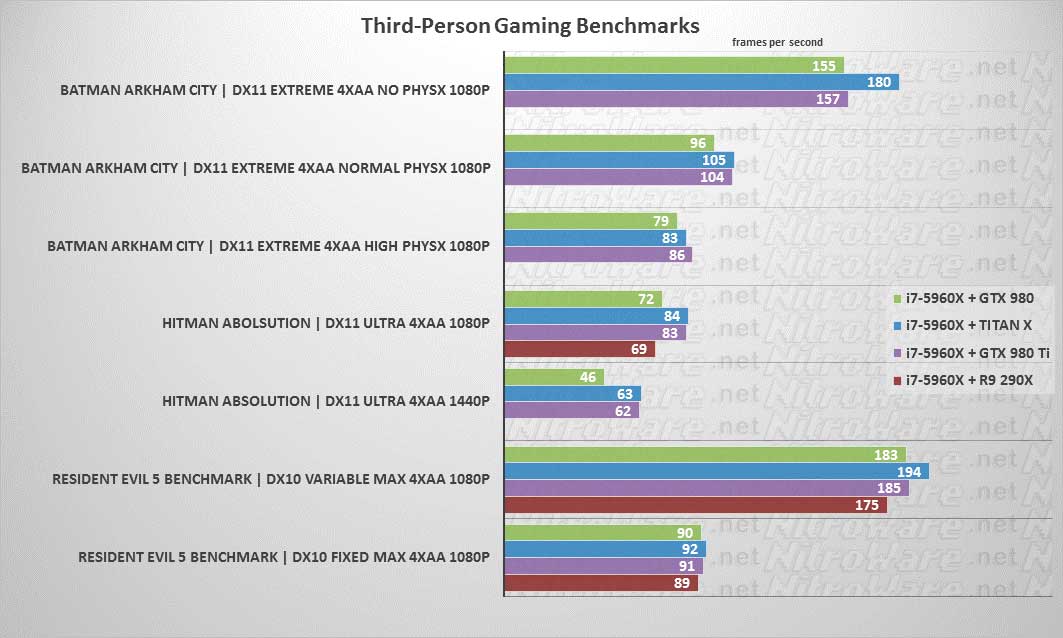
Resident Evil 5 serves as a platform limit test, where the complex Hitman and Batman titles become GPU limited due to their high texture and shader use. We want to compare the pair of TITAN X/980 Ti against 980 rather than individually.
Alien Vs Predator, Sniper Elite V2, Crysis 3, Metro 2033, Metro Last Light
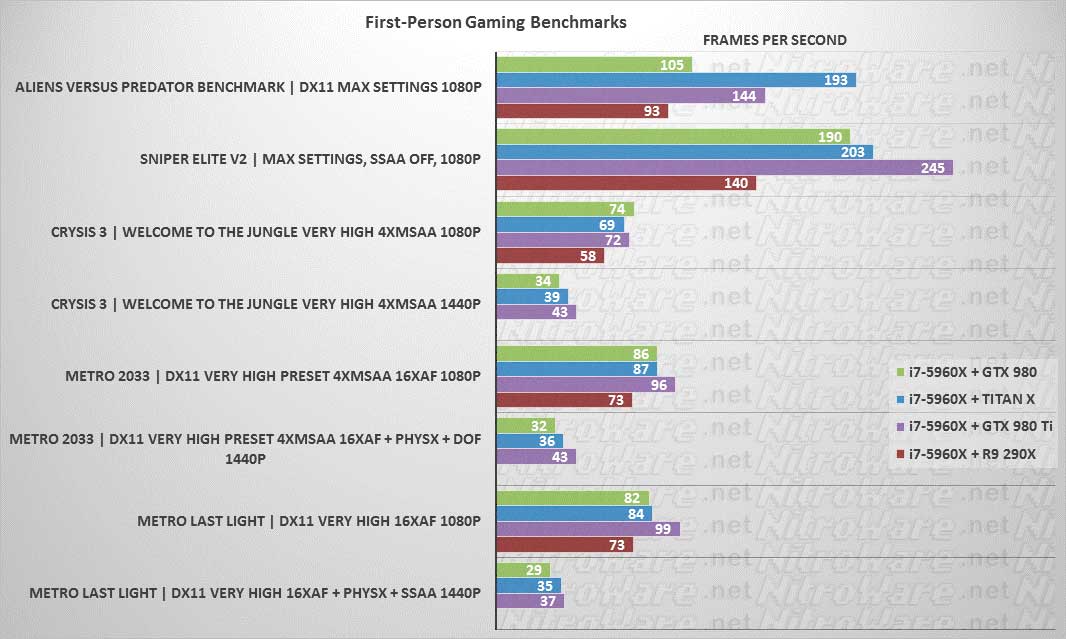
Sniper Elite’s benchmark does have an amount of variability in its results, however for the increase in performance for both metro titles we verified this with additional runs and can only conclude it is due to driver optimizations included since the original TITAN X drivers and optimized GPU boost behavior on the 980 Ti card.
Our Crysis 3 benchmark is the now ‘standard’ Welcome to the Jungle gauntlet run through the ruins of a train station and there is an amount of variability in each play through of the mission.
Street Fighter IV, Total War: SHOGUN 2, World In Conflict, Civilisation: Beyond Earth.
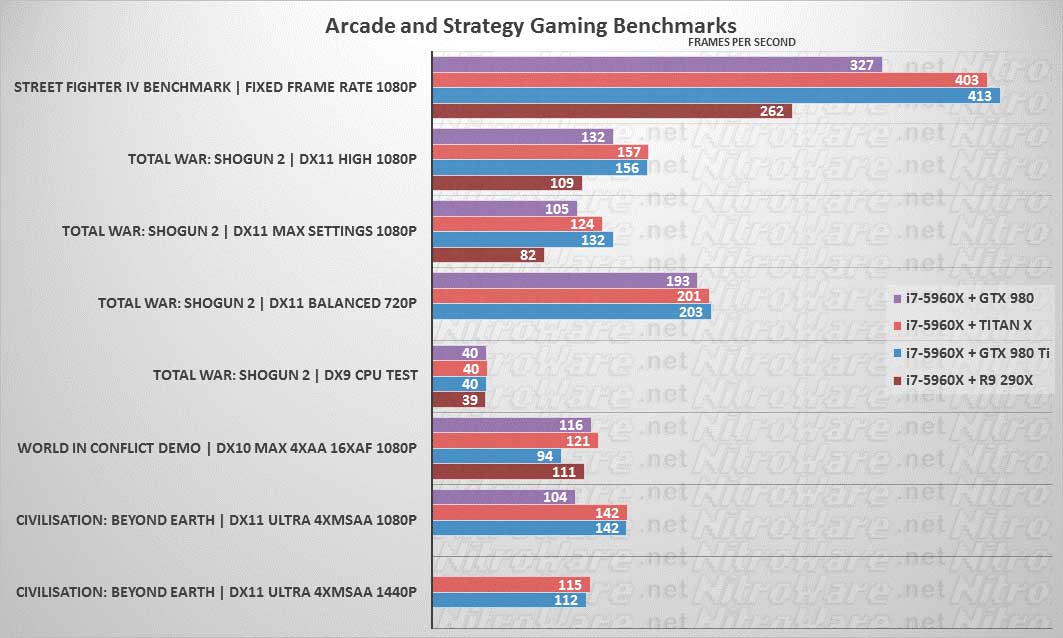
We were unable to test Civilization using Mantle on 290X due to the AMD review sample dying without replacement. Again we advise the 290X scores may be dated due to driver optimizations. Although World in Conflict is also a title that can show variance over runs, we did seem to find a regression in performance here.
GPU Compute and Professional Graphics Benchmarks
NVIDIA Maxwell 2nd generation uses CUDA 5.2 Kernel and many synthetic GPU computation benchmarks as well as productivity apps utilizing CUDA are not compatible. However we have tried to provide a mix and will continually optimize this suite of tests. Blender has always offered solid CUDA support and with the right settings to optimize rendering workload for GPUs can deliver good results with GPU acceleration enabled.
GPU Compute synthetic benchmarks using CUDA, OpenCL and DirectCompute
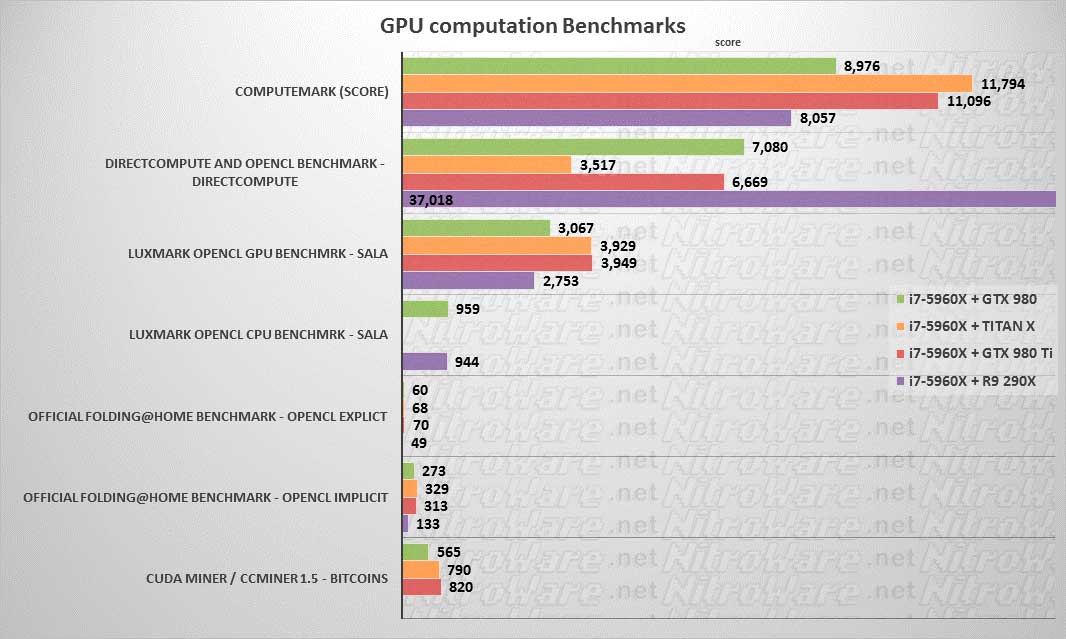
Finalwire’s AIDA 64 utilities and diagnostics software includes a GPGPU test which runs a series of memory benchmarks, integer math, encryption and hashing routines on the GPU. The results are not conclusive one way or another as again driver updates and GPU boost have an influence as you can see with the results presented.
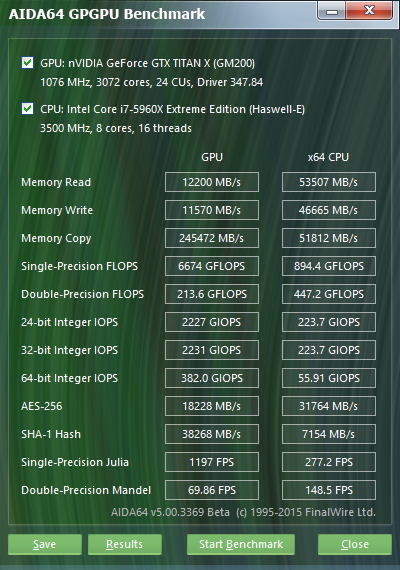
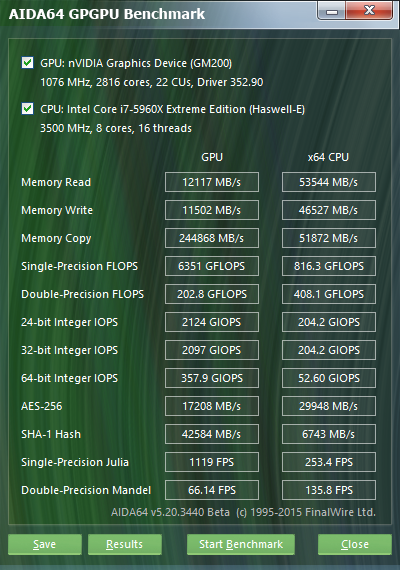
Blender
To gain optimal performance in blender, symmetrical render tile sizes need to be set in the application or poor performance is achieved. We used Blender 2.74 but Blender 2.75 Improves OpenCL support for AMD Radeon cards.
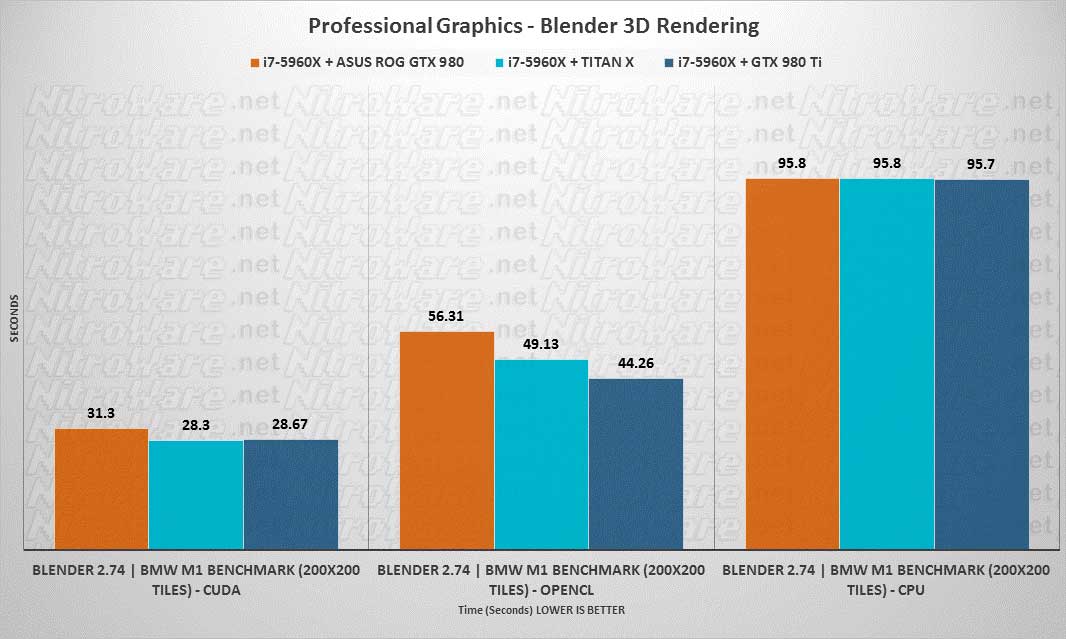
SPEC Viewperf 12
![GTX 980, GTX TITAN X, GTX 980 Ti, R9 290X SPEC Viewperf12 benchmark] spec viewperf 12 benchmark GTX 980, TITAN X, 980 TI, 290X](/images/stories/gtx980ti/8_specviewperf12.jpg)
Viewperf 12 is a viewer simulation of professional applications used in CAD/CAM. We run the ‘official’ test run. Although this benchmark is intended for professional GPUs with professional drivers it can show some trends and there are cases of these software being run on consumer grade hardware. In some of the tests such as CATIA, MAYA and AutoDesk we see the previously mentioned scaling between the different models of the Maxwell Core.
Power Consumption and Temperature
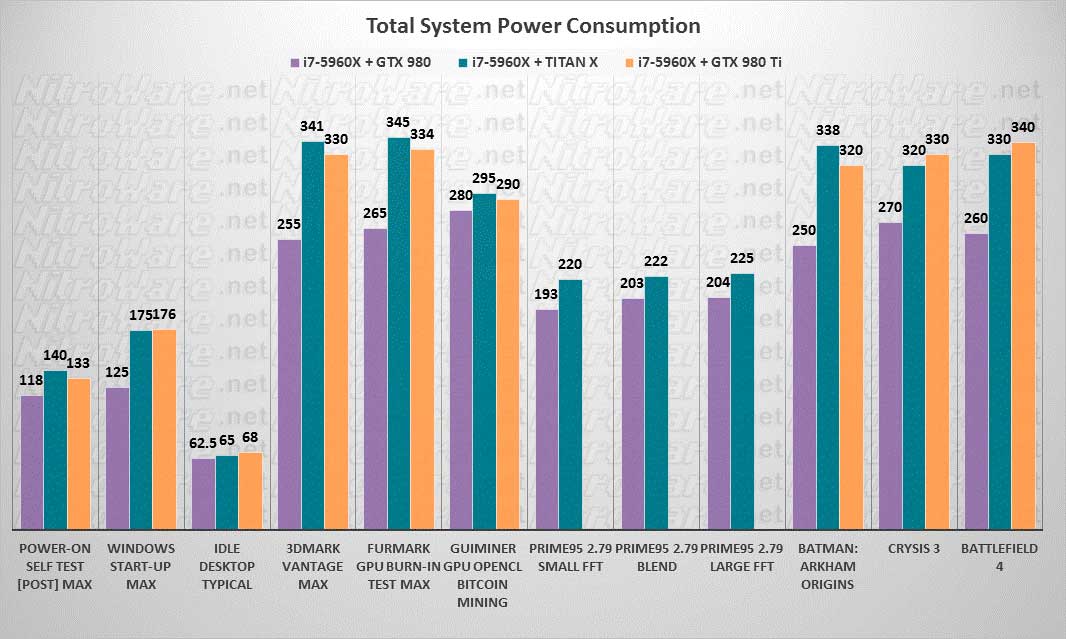
Since TITAN X has 10% more GPU cores than 980 Ti we would expect the TITAN to use more power when stressed with maximum GPU utilization and we do see that through Furmark, the feature tests of 3D Mark Vantage such as the Perlin noise tests and Batman Arkham Origins which implements Heavy GPU accelerated PhysX effects.
In a typical game play scenario versus a scripted benchmark, GPU utilization is constantly varying and is rarely ever 100% flat, combined with high boost speeds of 1200 MHz for the 980 Ti, this explains why the 980 Ti used more power in Crsys3 and Battlefield 4. We do our power tests at 1080P so in ideal situations the GPU should have some headroom to push boost speeds. Prime 95 CPU-only power draw tests and OpenCL bitcoin mining are provided as references.
Pricing and Avalibility
GeForce pricing is unchanged apart from new entry for 980 Ti and a price-cut for 980
- US $999 : TITAN X
- US $649 : 980 Ti
- US $499 : 980
- US $329 : 970
- US $199 : 960
At time of writing, Witcher 3 game bundle is applicable for some boards in some regions plus 980 Ti buyers get Batman Arkham Knight.
980’s price-cut leaves the former $549 US slot empty, as there is hardware wise with 980 Ti being 2816 CUDA cores and 980 being 2048 there is also an empty slot there in the product lineup. In the past NVIDIA have released gap filler products such as GTX xx5 GPUS or GTX XXX SP s with additional enabled shaders.
Although we are not privy to such information, rumors at press time do indicate a ‘metal’ GTX card in the works, which does fit into the product stack changes nicely.
US RRP is one thing, regional pricing is another. GTX 780/780Ti were expensive cards when new in outer regions such as Australia, with 680 being discounted as the case is now with 980.
As of 1-JUNE-2015, GTX 980 Ti launch day :
| Region | Vendor | Model | Local Price | USD |
|---|---|---|---|---|
| Australia | PC Case Gear | Gigabyte GeForce GTX 980 Ti 6GB | A $1049 | US $803 |
| Australia | PC Case Gear | EVGA GeForce GTX 980 Ti Superclocked 6GB | A $999 | US $764 |
| USA | Amazon | Gigabyte GeForce GTX 980 Ti 6GB | A $848.50 | US $649 |
The Australian pricing of A $999 is essentially correct.
US RRP or Amazon list price US $649 is $AUD $848.50. Plus 10% Goods and Sales Tax (VAT), comes to AUD $933. which if we consider distributor, channel and vendor markup equates to AUD $999. At time of this review, foreign purchases made by Australians do not include sales tax.
Third Party GTX 980 Ti boards
The two examples we found listed in Australia on launch day are reference cards we don’t need to elaborate on these.
Although 980 Ti’s launch coincides with Computex 2015, on launch day first off the bat to announce GTX 980 TI with custom PCB and cooler was ZOTAC, who have gone to town to emphasize the cooling and overclocking capabilities of their solution. Other Add-In-Board partners such as MSI and ASUS did announce their boards however these are recycled editions of their GTX 980s such as the MSI gaming red edition and ASUS Poseidon. The true enthusiast overclock happy editions such as an updated ASUS MATRIX, MSI Lightning or EVGA Classified/Kingpin would likely be months away to accord for development.
The Australian representatives for ASUS, MSI, EVGA and GIGABYTE did not provide us with information on their cards for the Australian market by press time.
In addition to a reference card, ZOTAC have four custom overclocked editions of 980 Ti, below plus an AMP! Omega
| Model | Base Clock | Boost Clock | Memory Clock | Cooler | Power | Length | Height | Width | Special Feature |
|---|---|---|---|---|---|---|---|---|---|
| AMP! | 1051 | 1140 | 7010 | Icestorm heatsink + 3x 90mm fans | 6+8pin 250W | 12.4 in | 4.38 in | 2 slot | Carbon ExoArmour |
| AMP! Extreme | 1253 | 1355 | 7210 | Icestorm Heatsink + 3x EKO Fans | 2x 8pin 258W | 13 in | 5.25 in | 2.5 slot | Powerboost module |
| ArcticStorm | 1025 | 1114 | 7010 | ArticStorm Copper Hybrid Cooler + 3x 90mm fan | 6+8pin 250W | 12.4in | 5.53 in | 2.5 slot | Carbon ExoArmour, Arctic style backplate |
Let us focus on the monster AMP EXTREME Zotac 980 Ti,as the others have slight overclocks. At 1253 core it exceeds the maximum overclock of 1200MHz we were able to get with the reference card, so should offer some serious kick in the pants performance. At launch time it is supposedly one of, if not the highest clocked 980 Ti announced. For 2.5 slots and what such an extreme card would be priced at, one would hope it would perform. In addition the overkill of a heatsink should provide reduced temperatures under load compared to the reference cooler.
During our testing of the ASUS ROG 980 we saw 10c reduction under load and the ZOTAC Extreme should be in such a ballpark. The only issues with this sort of card are its weight which will cause sagging (A support bar is included with the card) and price. ZOTAC has done something different with their visual ID and adopted the slogan ‘push the limit’, meant to be a catch-cry for overclockers on the back plate of its boards. Overclockers who are also fans of ‘Scarface’ can always pretend the card actually says ‘push it to the limit’ in reference to the film’s soundtrack…
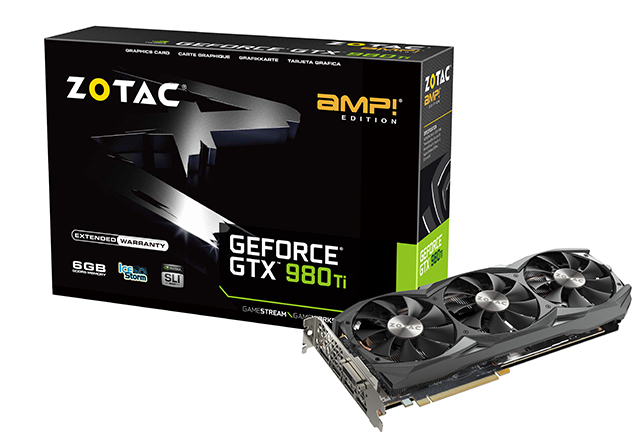
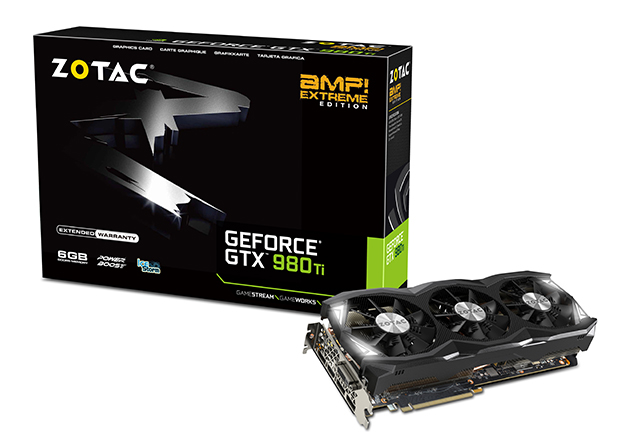
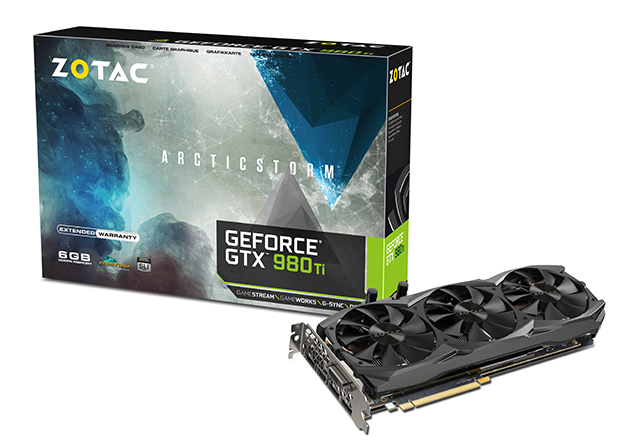
Verdict
A note on our benchmark testing.
We tested ‘worst case’ performance at 4K resolution with MSAA 4X and where applicable, maximum GPU PhysX enabled. This gives us a baseline to work off, to determine which features in a particular game are crippling performance. Our 8 core 5960X Intel i7 also has a slower multi-core clock speed compared to some of Intel’s i7s which have less cores. Lightly-Threaded games will suffer from the clockspeed deficit.
Additionally, once more applications supporting (Maxwell) CUDA 5.2, DirectX 12 and enabling features such as MFAA or VXGI will open up more performance.
Also a single 4K (3840x2160) 3D scene with 4x Multi Sample Anti Aliasing (MSAA) typically uses under 4 Gigabytes of Video Memory and it will take some effort or multiple Ultra HD screens to fully utilize the 12GB capacity, something which will be detailed in subsequent reviews. For our launch review we just went with the standard testing.
AMD RADEON R9 290X is not fairly represented in this review as AMD originally supplied us with a faulty card and refused to replace it, leaving us with an incomplete and now old set of benchmarks . Given regular driver updates, performance has since increased.
Pros
- Performance Per Dollar
- Dual slot 250W solution
- Thermal and acoustic performance
- 6GB Frame Buffer adequate for single monitor 4K ultra gaming
- Overclocked third party editions coming soon
- Reference card can be overclocked
- Bundled Batman:Arkham Knight game.
Cons
- Staying power Maxwell GPU is good now but will it still be good in 4-6months time?
- Reference card looks no different to a GTX 780 / No Backplate
- Like TITAN X, conservative fan profile limits performance in exchange for silence
- Not sufficiently faster than a heavily overclocked standard GTX 980
- NVIDIA cards typically have high launch prices, while US649 is reasonable, $1000 AU is a fair chunk of change and steep even for the enthusiast who has the budget to build a ‘killer rig’
GTX 980 Ti is set to replicate the success of the GTX 780 Ti both from end users and vendors alike. It delivers the performance of the more expensive GTX TITAN X without any caveats or penalties. For the time being it is THE GPU for the enthusiast.